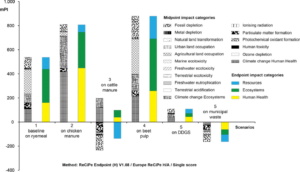Abel Manley
Why do we even need even a change from traditional protein? In today’s times it is certainly no secret that the current methods used globally for mass food production are generally inefficient and un-sustainable. The meat industry is certainly no exception to this. From chickens to cattle, farms consistently misuse the required resources to raise and grow their livestock, especially concerning waste production and excessive water use. Without proper diversification, the addition of livestock to a farm results in an increase in these inefficiencies which, on a global scale, can have a large impact on carbon output.
What role could insects play in the global food cycle?
From an environmental viewpoint, insects present a potential long-term option for a protein-rich meat substitute. With the proper harvesting techniques insects can be farmed at a large scale in a sustainable manner (Van Huis, 2017). One major factor that contributes to the eco-friendly nature of insect farming is the ability for a large-scale protein source to be grown with organic food waste or even properly sanitized fecal matter. Insects, then, could simultaneously provide a food source at mass while also making use of a resource that is often environmentally damaging when poorly disposed. However, the use of these wastes when feeding these insects resulted in a decrease in growth and nutrient efficiency (Smetana, 2016).

Fig 1. Sigle-score comparison of insect production scenarios
In order to optimize growth and nutrient efficiency the insects must be raised on a high nutrient diet, such as rye or wheat, which is inefficiently harvested and effectively negates much of the sustainable potential that the insects possess. As the efficiencies in the rye and wheat production increase to become more resource efficient and sustainable, the sustainable potential in insect farming would also increase. Despite this concern, as a result of lowered land, water, and energy use the application of insects for food and feed purposes still presents a more environmentally beneficial alternative to traditional sources of proteins (Smetana, 2016).
Would you eat a silkworm skewer?

Fig. 2: Fried silkworms
One of the major obstacles facing the growth of this new industry is the public perception of insect consumption. If the general public refuses to consume this protein alternative due to the mental perception it presents, then it simply does not matter how many caterpillar kebabs can be produced while maintaining carbon neutrality, it would have all been for nothing. So then, where does the average person stand on willingness to consume this alternative? As of 2017 over 70% of consumers are willing to taste insect alternatives experimentally, and the majority confirmed their willingness to cook and consume insects in the future. Interestingly, however, 75% of people expressed initial disgust at the prospect of consuming insects prior to receiving an info provision, but only 47% maintained this perspective after the provision. It is also notable that these numbers were consistently lower when considering the consumption of processed insect products that do not present the same “repulsive” appearance (Hartmann, 2017).
Can we expect to see insect products on the shelves in Migros?
As this industry currently stands there is still quite a bit of ground to cover before we can expect to see these products available to the everyday consumer. New technologies need to be enacted to increase efficiencies in production as well as additional studies to understand the optimal path to take concerning feed and harvesting techniques. In addition, there will need to increased awareness and education of the general public concerning this new concept before people will be open-minded and willing to incorporate insects into their daily diet. That being said, considering the relative youth of this growing industry, it is likely that both of these challenges will be overcome in the near future. In which case we could realistically expect to begin incorporating insects as a sustainable option on our dinner tables in the next years.
Bibliography
Gaspar, P., Mesías, F. J., Escribano, M., & Pulido, F. (2009). Assessing the technical efficiency of extensive livestock farming systems in Extremadura, Spain. Livestock Science, 121(1), 7-14
Hartmann, C., & Siegrist, M. (2017). Insects as food: Perception and acceptance. Findings from current research. Ernahrungs Umschau, 64(3), 44-50.
Smetana, S., Palanisamy, M., Mathys, A., & Heinz, V. (2016). Sustainability of insect use for feed and food: Life Cycle Assessment perspective. Journal of cleaner production, 137, 741-751.
Van Huis, A., & Oonincx, D. G. (2017). The environmental sustainability of insects as food and feed. A review. Agronomy for Sustainable Development, 37(5), 1-14.